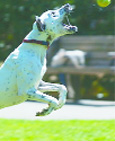By Miranda Beninger –
 There are over 250,000 registered dogs in the city of Toronto, and not enough off-leash parks to exercise them, according to Leslieville councilor Paula Fletcher.
There are over 250,000 registered dogs in the city of Toronto, and not enough off-leash parks to exercise them, according to Leslieville councilor Paula Fletcher.
Off-leash areas in the city encourage community interaction and happy dogs, but it’s not always a walk in the park trying to create a harmony between the sports teams, dog-owners, cyclists and children all sharing a common ground.
That’s why Fletcher has been collaborating with Toronto Parks, Forestry and Recreation to produce an official policy about off-leash zones for dogs in the city. The policy has been in the works for five years, and will finally be implemented in the fall.
The final product—called the People, Dogs and Parks Off-Leash Policy – was recently approved by the council.
Until now, there has been no uniform standard for off-leash parks. Fences, designated times for walking and rules about where you can and cannot keep your dog on a leash are inconsistent. Parks like Allen Gardens, Cawthra Square and Greenwood Parks in the Downtown core all have different rules.
Common complaints about the areas include owners not picking up after dog waste, not controlling their dogs around children and allowing dogs to drink from public swimming pools or water fountains.
In Greenwood Park, conflicts have arisen and dog owners have not always complied with the 6 a.m. to 8 a.m. hours. Fletcher, along with her constituency assistant Richard Dector, have worked to come up with solutions.
“There is a working group of parents of young children, dog-owners, dog-walkers, and city staff trying to enhance the park and balance the needs of the whole community,” says Dector.
In other parks conflicts have also arisen in regards to the inconsistency of regulations being enforced in the past. In Allen Gardens, there have been complaints about damage to the gardens and issues complying with off-leash rules. In Cawthra Square, there have also been issues with dog owners not complying with the designated off-leash times.
The new regulations could mean more off-leash areas in the city long term. In the coming weeks, an application will be released by the city for citizens so they can apply for an off-leash zone in their neighborhood park.
As for existing off-leash areas, there may be more scrutiny coming from community members and officials. Off leash areas that are near paths used for cycling, children’s play areas, wading pools and environmentally sensitive areas will not be considered appropriate off-leash areas and could be restricted after inspection.
All existing off-leash areas will all be re-evaluated and will be dealt with on a case-by-case basis. If there is a high-volume of complaints, the areas will then be assessed to determine their continuation as off-leash zones.
Fletcher and other policy collaborators emphasize that owners must help take responsibility for their pets to ensure the continuation and growth of off-leash zones for dogs. They hope additional monitoring will help keep everyone happy—including the dog owners.
The commercial dog walker policy is also being implemented this fall. Those operating commercially and walking more than four dogs will have to obtain a permit.
Applications for off-leash parks and dog walkers will be made available in the coming weeks.
 TheBulletin.ca Journal of Downtown Toronto
TheBulletin.ca Journal of Downtown Toronto

